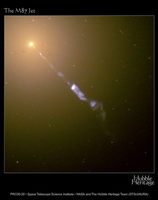The close by, massive, jet-forming black hole in the nucleus of the galaxy M87 has been famously imaged by the Event Horizon Telescope. This has been generally interpreted in the context of an orbiting ring of gas that glows steadily. An alternative class of "ergomagnetospher" models posits that the magnetic field strength is much greater and we are observing individual flares associated with the "snapping" of magnetic field. If so we expect to see this reflected in the spectral-temporal-polarization behaviour or "crackle" measured. Typical flares may be accompanied by fainter echoes which can also be sought statistically and individually. A spinning black hole will associate a characteristic caustic surface with the observer. A small spark within the ergomagnetosphere can traverse this caustic, forming four highly-magnified images which move rapidly around the Einstein ring. in a generic fashion. These occasional "Pops" are also being sought in existing data. A simplified description of geometric optics in Kerr spacetime will be presented and the various observable consequences of having a strong magnetic field will be outlined with a view to inferring the sources of emission. Application to other black hole sources will be outlined.
Snap, Crackle and Pop: Flares, Variability and Caustics from the Black Hole in M87

Host: Bart Ripperda

